Elephant Medallion
Sold
Details
Authentic rare bronze Greco-Baktrian Kingdom coin of Demetrius I Aniketos minted circa 200-185 B.C. set in 18K yellow gold with double-set citrine and garnet cabochons.
Handmade in Rome, each piece is unique.
History
Measurements
Delivery
Care
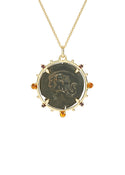
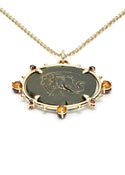

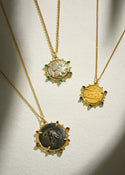
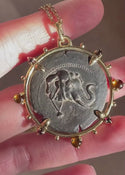
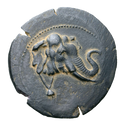
Demetrius I Aniketos
(TRICHALKON)
(TRICHALKON)
Demetrius I (c. 167-222 B.C.) was the Indo-Greek ruler of the kingdom of Bactria. His victories in India are highlighted on this coin through the symbolism of the elephant. The elephant was also a frequent emblem of wealth and achievement.
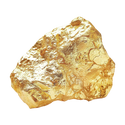
Gold
(18K)
(18K)
It is a dense, soft, malleable, and ductile metal. Gold is highly valued for its beauty, rarity, and resistance to corrosion. It does not tarnish or corrode over time, making it a perfect choice for jewellery.
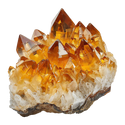
Citrine
(QUARTZ)
(QUARTZ)
Citrine, a stunning yellow gemstone, has been cherished for millennia, often regarded as a gift from the sun. Its name, derived from the French word 'citron' for lemon, perfectly captures the bright, distinctive allure of this gem.
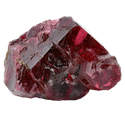
Garnet
(SILICATE)
(SILICATE)
Garnet, typically seen in striking hues of red or orange, is a captivating gemstone that has been precious for millennia, with beads dating back to 3000 B.C. attesting to its timeless allure.
Our items are handmade in our atelier in Rome.
Delivery is estimated at 4-6 weeks from when the order is placed with the atelier, but we always endeavour to deliver sooner. Our team will be in touch to keep your updated at every stage of production.
Alternatively please contact shop@dubini.co.uk




